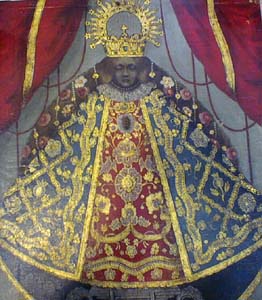![[Metroactive Features]](/features/gifs/feat468.gif)
[ Features Index | San Jose | Metroactive Central | Archives ]
 Photograph by J. Douglas Allen-Taylor Black Madonna Looking to the ancient Catholic icon for power By J. Douglas Allen-Taylor ON THE WEEKEND when I spent half my time watching the decidedly macho sprint-highly-and-bodyslam of the NCAA's Final Four basketball tournament, I suppose I should have felt out of place in a crowd of women singing and talking and meditating about the feminine face of God. After thinking about it for a while, I decide that I am not. If God is a woman, I'm counting on her liking men. This is the all-day "Power of the Black Madonna" conference at De Anza College in Cupertino, which is sponsored by the University of California Santa Cruz Extension and coordinated by author, journalist and UC-Berkeley religious scholar China Galland. The program offers credit for UCSC Extension students. In the cavernous, air-cooled Campus Center, participants slip off their shoes, meditate, join in song, clap rhythmically and, at one or two points, are moved to quiet tears. The crowd, made up almost entirely of women, runs the gamut in dress--pantsuits, jeans, sweatshirts, tie-dyes, dashikis. A few men are scattered around, and they have a gentle, beatific look about them. The venue is pro-human from a feminine point of view, rather than either feminist or anti-man, and "cross-culture" is the catchword of the day. A group of singers in various stages of footwear, from booted to barefoot, are plucking on instruments several hundred years old as they perform 14th-century Catalonian chants. An African American spiritual performer traces rhythms and melodies that originated in pre-slavery Africa, crossed the Atlantic in the Middle Passage, passed through Baptist hymnals and ended up in urban contemporary disc sounds. A Latina graduate student finds radical and erotic symbolism in depictions of the Virgin Mary, including assertions that the Madonna images include representations of the constellations, a vulva, and calls to revolution. Tables surrounding the auditorium display paintings, postcards and shrines to various goddess figures. Galland sees the ancient Catholic icon of the Black Madonna as a symbolic religious depiction that unites first women, and then women and men, across cultural, national and ethnic boundaries, stretching over recorded time and uniting with a host of "dynamic and powerful images of dark female divinities [which] have existed in churches and temples throughout the world for millennia." "Black or Dark Madonnas are patrons of Catalonian Spain, Switzerland, Poland, Italy, Brazil, Argentina and Mexico, to mention only a few," Galland writes. "Why is the Madonna dark or black? Like a river, her darkness comes from a multiplicity of streams such as black meteorite stones that fell out of the sky and were then venerated. The awareness of this ancient, cross-cultural figure of the Dark Mother is growing now because we need the awareness she brings: the indivisibility of our relationship with each other and with the Earth and with all her creatures." Vocalist Linda Tillery of Oakland, founder of the Cultural Heritage Choir, quietly jokes that when growing up in the black church, she had thought that the only way to worship was to be loud and energetic. She explains that such practices are common in the African American religious experience with its African roots. Many of the haunting medieval Spanish religious songs performed by the Harlot Saints group have an Arabic air to them, distant echoes of the time when southern Spain was occupied by the Moors. UC-Berkeley graduate student Irene Lara, who describes herself as a California Chicana, talks about the Native American and African religions that merged with Catholicism during the period of colonialism and European world expansion. "The indigenous had to hide under Mary's skirts in order to survive," she says. In between recitations of her own erotic poetry, Lara presents a slide show that highlights the various depictions of the Virgen de Guadalupe, the Mexican national religious symbol. The images evolved from a cloaked and covered, demurely praying icon to a goddess-warrior brandishing a snake in her fist to a bare-breasted woman unashamed of her mature sexuality. Some of the images show a direct correlation between ancient indigenous spiritual icons and modern hip-hop mural art. Galland realizes that the conference is preaching mostly to the already converted but sees the efforts as a continuing spark attempting to light a greater fire. "This is a movement, very similar to the civil rights movement," the soft-spoken Galland explains in the hallway during a break in the conference. "We are empowering people to take control of their lives ... to take back control of the earth." [ San Jose | Metroactive Central | Archives ]
|
From the April 13-19, 2000 issue of Metro, Silicon Valley's Weekly Newspaper.
Copyright © 2000 Metro Publishing Inc. Metroactive is affiliated with the Boulevards Network.
For more information about the San Jose/Silicon Valley area, visit sanjose.com.